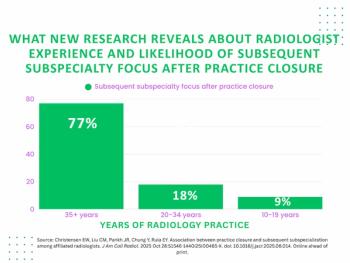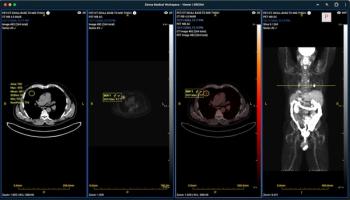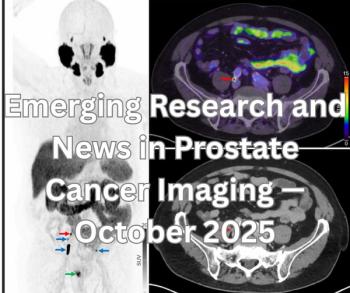
Achieving Success in a Turbulent Healthcare Landscape
The top considerations for radiology practices.
Radiology practices have a tremendous opportunity in 2021 to grow and invest in their businesses, and most importantly, to drive meaningful cost and quality improvement to the broader health care industry and to be a leader in providing value-based care.
2020 was a challenging year, with the healthcare industry fundamentally altered by the COVID-19 pandemic, forcing radiology practices to quickly adapt. The pandemic served as a wake-up call for radiology leaders to innovate and evolve how they operate to build stronger and more resilient models. In many cases, groups were able to identify opportunities for cost efficiencies that will serve to reduce unnecessary overhead and infrastructure.
What considerations should radiologist practice leaders be making in order to position their practices optimally in 2021 and for the future?
Radiology leaders have a sizable opportunity to drive value-based care into the 21st century, but that value creation will not happen overnight. Practices must be proactive and make critical platform investments to capture forthcoming opportunities.
A proactive mindset must consider key factors affecting the radiology and healthcare landscape today. Here is an overview of today’s radiology practice landscape, outlining the top considerations, opportunities and factors all radiologists must understand in order to be best positioned for success:
Today’s Radiology Landscape: Critical Factors
As practices adjust to 2021, here are the top themes affecting radiology practices in the upcoming year:
Federal Government Healthcare Policy Changes
Center for Medicare & Medicaid Services (CMS) announced the new Medicare
Industry Consolidation and Mergers
RadPartner’s $885-million acquisition of Mednax Radiology adds 800 radiologists, bringing the company’s total enterprise to more than 2,400 radiologists nationally. This consolidation continues a recent consolidation trend in radiology: there were 23 practice transactions in 2018, followed by a record-high 25 in 2019, and, then, 11 in 2020. While the pandemic reduced the amount of consolidations in the first three quarters of 2020, we saw activity in Q4 2020 returning back to 2019 levels.
Groups of all sizes should pay close attention to increasing consolidation and the possible benefits that come with greater scale, including clinical research, technology, expanded services and greater geographic reach. While joining a larger national platform may not be ideal for every group, those that wish to remain independent should certainly make investments today to bolster potential gaps and increase competitiveness in the market.
Push to Outpatient Services and Consumerization
In 2020, outpatient volume increased about 10.5 percent, and early trends show this shift continuing in 2021. Patients prefer to visit outpatient environments and managed care is certainly aligned in steering patients to lower-cost outpatient imaging centers over higher cost hospital sites.
COVID-19 has certainly driven a higher “retail” consumption of healthcare with patients being accustomed to services being offered in a much more convenient fashion. Gone are the days of waiting for hours for care in a crowded waiting room or filling out paper forms. Even after the COVID-19 recovery, patients will continue to demand a higher touch, more digital and streamlined experience.
Private practices need to re-evaluate their outpatient and broader consumer strategy, and if one does not exist, they should quickly create and implement one. Radiology groups that are 100 percent dependent on hospital revenue should assume that volume will continue shifting away from hospitals, in favor of free-standing outpatient centers. Groups should also understand that their long-term success is increasingly driven by innovative marketing departments that bolster consumer recognition in the market. Forward-thinking radiology groups are investing in digital marketing, building app-based scheduling capabilities, embracing telemedicine, and driving towards a modern consumer experience.
COVID-19 and its Impact on the Economy
COVID-19’s continued spread and lasting impact has created an avalanche of challenges for the U.S. healthcare system. There have been massive reductions in elective procedures and operational changes required to deliver care safely. Many Americans have lost their health insurance as a result of job loss.
Medicare’s Reallocation of Payments
A ramification of CMS’ specialty practice ruling is the reallocation of Medicare payments that benefits general practitioners, family practice providers and nurse practitioners. This reallocation comes at the expense of specialty practices like radiology groups.
Payors are also incentivizing patients to opt for care in lower-cost settings, away from hospitals, and hospitals are responding by increasing their outpatient footprint. Lastly, payors are moving deeper into primary care, imaging, and urgent care as a means to exert greater influence in the overall flow of care across their ecosystem.
In light of these issues and challenges facing our healthcare system, radiology practice leaders must recognize that they are at a critical crossroads and must think strategically about how to position themselves optimally for the future.
As radiology practices consider how to best strengthen their positioning for the future, Ziegler recommends conducting a SWOT analysis to identify areas for investment and fortification.
Once a SWOT analysis and strategic plan is formalized, it is vital to execute on that plan and make the necessary investments in a prudent fashion. The success of that plan is however dependent the success of its execution.Ziegler has outlined below a six-step process to ensuring the greatest degree of success in the execution of any strategic plan.
While coping with external pressures, such as COVID-19, reimbursement pressures, and industry consolidation can be daunting, creating a long-term strategic plan that deepens competitive differentiation and builds scale is critical for ensuring long-term sustainability and maximizing shareholder value.
It is not practical to make all investments at once, but the key is to outline a one-year, five-year and 10-year investment plan and to stick to it. Incremental growth is best as it is most manageable, demonstrates practice momentum and helps ensure your practice is nimble and agile to adjust for previously unforeseen events, such as COVID-19 or abrupt market changes.
The physician practices that will fare best in 2021 and beyond will undoubtedly be those that have made strategic investments in their platforms, bolstering their ability to scale and ready to address whatever challenges the future might bring.
[1] Source: Banthin et al,, “Changes in Health Insurance Coverage Due to the COVID-19 Recession: Preliminary Estimates Using Microsimulation,” Urban Institute, July 2020.
— Andrew Colbert is a senior managing director and founding member of Ziegler's Healthcare Investment Banking practice. Andrew has represented more than 20 radiology groups on innovative transactions. He specializes in advising physician groups on strategic and financing alternatives including merger and acquisitions, joint ventures, capital raising transactions, and partnership development. More information is available at www.ziegler.com/radiology.
Ziegler is a privately held, national boutique investment bank, capital markets and proprietary investments firm. It has a unique focus on healthcare, senior living and education sectors, as well as general municipal and structured finance. Headquartered in Chicago with regional and branch offices throughout the U.S., Ziegler provides its clients with capital raising, strategic advisory services, fixed income sales, underwriting and trading as well as Ziegler Credit, Surveillance and Analytics. To learn more, visit www.ziegler.com .
Information contained or referenced in this document is for informational purposes only and is not intended to be a solicitation of any security or services.” “B.C. Ziegler and Company | Member SIPC & FINRA.
Newsletter
Stay at the forefront of radiology with the Diagnostic Imaging newsletter, delivering the latest news, clinical insights, and imaging advancements for today’s radiologists.






























